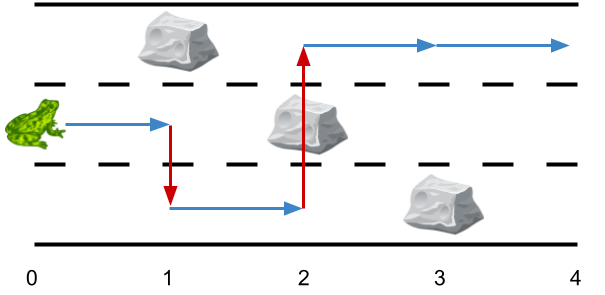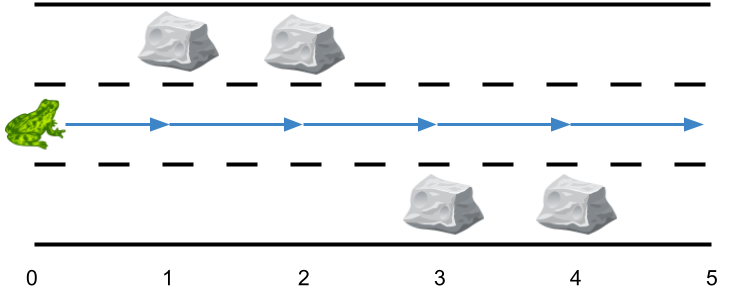
g1801_1900.s1824_minimum_sideway_jumps.readme.md Maven / Gradle / Ivy
Go to download
Show more of this group Show more artifacts with this name
Show all versions of leetcode-in-java Show documentation
Show all versions of leetcode-in-java Show documentation
Java-based LeetCode algorithm problem solutions, regularly updated
The newest version!
1824\. Minimum Sideway Jumps
Medium
There is a **3 lane road** of length `n` that consists of `n + 1` **points** labeled from `0` to `n`. A frog **starts** at point `0` in the **second** lane and wants to jump to point `n`. However, there could be obstacles along the way.
You are given an array `obstacles` of length `n + 1` where each `obstacles[i]` (**ranging from 0 to 3**) describes an obstacle on the lane `obstacles[i]` at point `i`. If `obstacles[i] == 0`, there are no obstacles at point `i`. There will be **at most one** obstacle in the 3 lanes at each point.
* For example, if `obstacles[2] == 1`, then there is an obstacle on lane 1 at point 2.
The frog can only travel from point `i` to point `i + 1` on the same lane if there is not an obstacle on the lane at point `i + 1`. To avoid obstacles, the frog can also perform a **side jump** to jump to **another** lane (even if they are not adjacent) at the **same** point if there is no obstacle on the new lane.
* For example, the frog can jump from lane 3 at point 3 to lane 1 at point 3.
Return _the **minimum number of side jumps** the frog needs to reach **any lane** at point n starting from lane `2` at point 0._
**Note:** There will be no obstacles on points `0` and `n`.
**Example 1:**

**Input:** obstacles = [0,1,2,3,0]
**Output:** 2
**Explanation:** The optimal solution is shown by the arrows above. There are 2 side jumps (red arrows). Note that the frog can jump over obstacles only when making side jumps (as shown at point 2).
**Example 2:**

**Input:** obstacles = [0,1,1,3,3,0]
**Output:** 0
**Explanation:** There are no obstacles on lane 2. No side jumps are required.
**Example 3:**

**Input:** obstacles = [0,2,1,0,3,0]
**Output:** 2
**Explanation:** The optimal solution is shown by the arrows above. There are 2 side jumps.
**Constraints:**
* `obstacles.length == n + 1`
* 1 <= n <= 5 * 105
* `0 <= obstacles[i] <= 3`
* `obstacles[0] == obstacles[n] == 0`© 2015 - 2024 Weber Informatics LLC | Privacy Policy